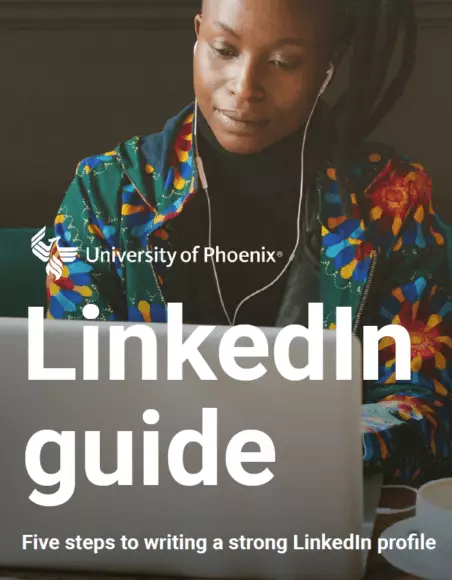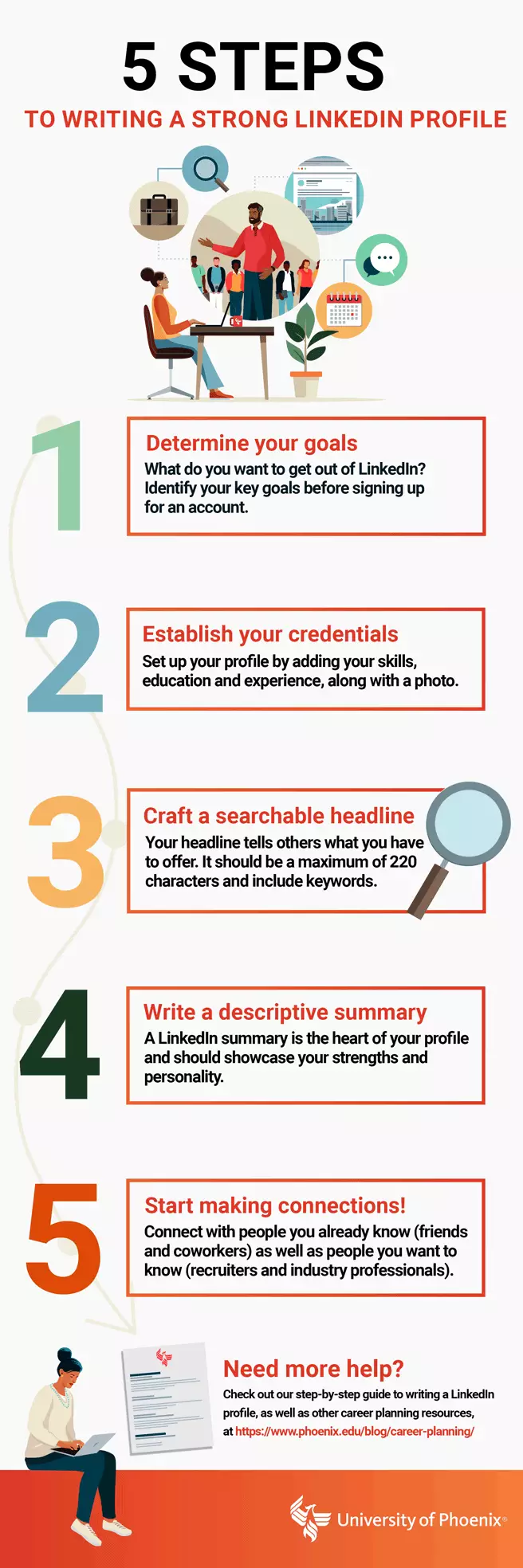5 ways to optimize your LinkedIn profile. Today.
At a glance
- An optimized LinkedIn profile is essential for online networking.
- Professional networking sites like LinkedIn require a specific approach to bolster your professional credibility and personal brand. This process includes strategic language and continued engagement.
- LinkedIn profiles aren't just for those on the job market. Employed individuals and students can also benefit from the site.
- If you need more help, download our step-by-step LinkedIn Guide (PDF)
on how to create an optimized LinkedIn profile, which includes additional tips and resources.
What is LinkedIn?
LinkedIn is that rare, mythical-like creature of the networking world. Not quite social media and more than a job board, it attracts established professionals, aspiring students and everyone in between. With an upward of 750 million users in 2020, however, two things is clear: There’s no ignoring this professional networking powerhouse. And you need to optimize your LinkedIn.
That means that posting selfies on Instagram with the hope of landing a great job is about as effective as ignoring online networking altogether. Nowadays, all competitive candidates in the job market need a solid resumé, strong interviewing skills, and, yes, a LinkedIn profile.
Need a step-by-step guide to setting up your LinkedIn profile? Check out our LinkedIn Guide !
Click on the image to download our step-by-step guide to optimize your LinkedIn profile.
1. Why use LinkedIn?
LinkedIn launched in 2003; by 2005, it had grown to offer job listings and search capabilities. By 2007, it was profitable, and the rest, as they say, is history.
Except that it isn’t: LinkedIn continues to play a vital role in the professional networking sphere. Users rely on it for a variety of reasons, from keeping in touch with colleagues (past and present) to networking to staying in the loop on industry trends. According to the latest statistics, 40 million people use LinkedIn every week to search for jobs, and three people a minute are hired on the site.
Even more compelling? Some 44% of LinkedIn users earn more than $75,000 a year. That’s a considerable bump up from the national median income of $68,703 per household.
It’s this hope of a happy ending to a job search that seems to most effectively motivate people to visit LinkedIn’s homepage and click on that promising blue button containing the words, "Get Started." It’s what drives people to slog through the writing and refining of the small-but-mighty. It’s what keeps people coming back daily (or more frequently) to check their feed, send messages and click "Celebrate" or "Curious" or one of the four other response options that tell the world you are an engaged user.
LinkedIn, in other words, is an easy and powerful tool to leverage in your job search. But first, you have to know how to optimize your LinkedIn profile.
2. The basics
Setting up your account can feel deceptively straightforward. Add a picture? No problem, you might think. "I’ve got one from that last girls’ weekend in Cabo."
And that would be your first mistake. LinkedIn is a professional networking site; the emphasis being on "professional." Your photo should speak to both your credibility and your personal brand.
Steven Starks, the senior manager of career advising programs and operations at University of Phoenix, puts it this way: "Think about how you’d want to present yourself to your potential future boss. Your photo is your digital first impression."
This means you should use a headshot with a background that doesn’t distract from your smiling face. (Yes, you need to smile. Would you scowl at a job recruiter?) If you have a professional shot, use it. If not, keep it simple with just your face in the frame against a solid background.
3. Strategic language
From there, you’ll need to strategically beef up your profile. Consider where you want to go and how your experience relates. And keep an open mind throughout this process! For example, if that nanny gig is where you discovered your passion for child development — and it’s what led you to pursue a career in, say, psychology — include it. But if a job didn’t teach you a valuable skill, or it doesn’t enhance your brand or relate to the career you’re pursuing, leave it out.
Next, optimize your LinkedIn by adding keywords that are relevant to your industry and experience and make your profile that much easier to find. Finally, consider adding work-related media, such as videos and presentations; articles and publications that feature you; and your personal website and portfolio.
This isn’t bragging, mind you. It’s branding.
In creating a fully formed picture of yourself, through well-written copy, appropriate imagery and media that speak to your accomplishments, you are (re-)introducing yourself to potential contacts and employers.
Need additional career support? Visit the University of Phoenix YouTube channel to hear 5 tips for writing a LinkedIn profile from UOPX career advisor Carla Hunter.
4. Post-profile steps
Once you’ve completed your profile, the next step to optimize your LinkedIn profile is to stay engaged. Consider joining groups and connecting with your connections’ connections. (When you reach out to connect, especially with someone you don’t know very well, include a personalized message like, "I really liked the article you wrote/posted on such-and-such.")
Also, ask for recommendations and endorsements. The worst someone can say is no, and getting those honest evaluations on your profile makes a recruiter’s job a little bit easier when highlighting your skills to a potential employer.
Again, be strategic. Think about which qualities or experience you want to highlight, find people who have worked with you in those areas and ask them to mention those things in their recommendations.
For example, if you want to move into project management, request a recommendation from someone with whom you collaborated and ask that he or she specifically speak to your project management capabilities. Not only does this help you fine-tune your LinkedIn profile, but it also helps the person writing the recommendation know what to focus on.
5. Stay prepared
Not exactly in the job market yet? That’s OK. According to TopUniversities.com, students can actually benefit from staying engaged on LinkedIn even while they’re in school. They can use the site to research a company ahead of an interview, for example, and to showcase themselves as committed job candidates. Eventually, they might even join this rather impressive statistic: 50% of college graduates in the U.S. use LinkedIn.
All these methods are great ways to expand your network and potentially find your next opportunity. After all, more than 57 million companies have a presence on LinkedIn — and you never know who’s looking for someone like you.
Deciding on the right career path isn’t easy. Make sure your first step is the right one.
read similar articles









